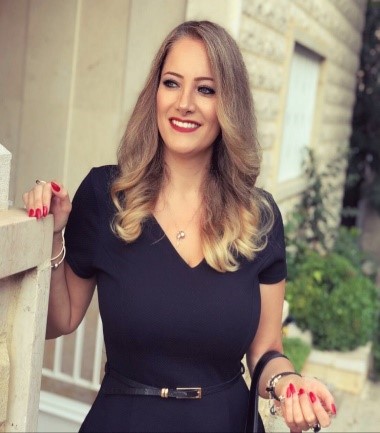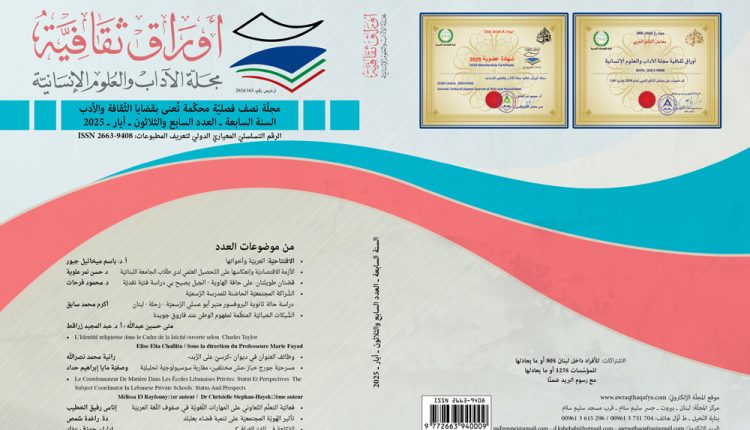عنوان البحث: Gebran Tarazi… The Functionalistic and the Aesthetic
اسم الكاتب: PhD. Assim Abdel Amir, Rana Saïfi
تاريخ النشر: 13/05/2025
اسم المجلة: مجلة أوراق ثقافية
عدد المجلة: 37
تحميل البحث بصيغة PDFADOI: https://aif-doi.org/awraq/013717
Gebran Tarazi… The Functionalistic and the Aesthetic
جبران طرزي… الوظائفي والجمالي
د.عاصم عبد الأمير[1]PhD. Assim Abdel Amir
المترجِمة رنا صيفيّ[2]Rana Saïfi (Translator)
Summary (abstract)
A visionary artist, Gebran Tarazi’s (1944–2010) work merged structural beauty, abstraction, and oriental traditions. His art used geometric abstraction to unveil deeper aesthetic truths. Tarazi’s pieces of art struck a balance between classical and modern influences, creating harmony through shapes like rectangles and squares.
He drew inspiration from Arabesque and “Vertical-Horizontal” (Qayem-Nayem) patterns, rooted in his oriental heritage. His works—spanning paintings, furniture, and decorative objects—showcased mastery in color, rhythm, and geometric precision. Beauty, in the eyes of Tarazi, was an intrinsic, almost spiritual force, aligning with Platonic ideals of form and function. He blended functionalism with artisanship, merging craftsmanship with abstract expression. His work often featured repetitive motifs, creating optical movement and depth. He rejected replication, valuing creativity over conventional. He maintained a cultural identity tied to his family’s legacy in oriental Damascene craftsmanship. His work bridged Eastern and Western aesthetics, emphasizing geometric purity. Influenced by Kandinsky and Mondrian, he explored non-material dimensions of form. Functionalism in his art served a deeper purpose—preserving cultural identity rooted in tradition. Tarazi’s legacy lies in his unique synthesis of heritage, geometry, and timeless beauty.
ملخص
جمع جبران طرزي (1944–2010)، وهو الفنان الرؤيوي، بين الجمال البنائي والتجريد والتقاليد الشرقية في أعماله. استخدم في فنه التجريد الهندسي لكشف حقائق جمالية أعمق. وحقّقت أعماله الفنية توازنًا بين النزعة الكلاسيكية والحداثة، مُولّدة انسجامًا عبر الأشكال مثل المستطيلات والمربعات.
استمدّ طرزي إلهامه من الزخارف العربية وأنماط “القائم-النائم”، المستقاة من تراثه الشرقي. تظهر أعماله – من لوحات وأثاث وتحف زخرفية – براعة في استخدام اللون والإيقاع والدقة الهندسية. الجمال في نظر طرزي قدرة جوهرية تكاد تكون روحانية، تُحاكي المُثُل الأفلاطونية للشكل والوظيفة.
دمج بين الوظائيفية والحرفية، بين الإتقان اليدوي والتعبير التجريدي. تميّزت أعماله بتكرار الزخارف والأنماط، مما خلق حركة بصرية وعمقًا في أعماله. رفض النسخ، مُعليًا شأن الإبداع على المألوف. حافظ على هوية ثقافية مرتبطة بإرث عائلته في الحرف المشرقية الدمشقية.
شكّلت أعماله جسرًا ربط بين الجماليات الشرقية والغربية، مع تركيز على النقاء الهندسي. متأثرًا بكاندينسكي وموندريان، استكشف الأبعاد غير المادية للشكل والتراكيب. سخّر الوظائيفية في فنه لغاية أعمق وهي الحفاظ على الهوية الثقافية المتجذّرة في التقاليد. وإرث طرزي يكمن في التوليف بين التراث والهندسة والجمال الخالد.
الكلمات المفاتيح: أشكال – الأصالة والحداثة – التباينات اللونية – تجانسات وتعارضات – التجريد التوليدي – التجريد الهندسي – التشكيل – التراث والحداثة – التراكيب – التصاهر – التكرار البصري – جبران طرزي – الجمال – الجمال البنائي – الحرفية والفن – الدمشقي…
Keywords: Forms – Authenticity and Modernity – Color Contrasts – Analogies and Contrasts – Sequential Abstraction – Geometric Abstraction – Modelling – Heritage and Modernity – Compositions – Visual Repetitions – Fusion – Visual Repetition – Gebran Tarazi – Beauty – Structural Beauty – Craftsmanship and Art – Damascene…
-
![]()
د.عاصم عبد الأمير Analogies and Contrasts
If it’s been said that Beauty is a structural feature intrinsic to the Being, given that every creative speech stands out based on the unmatched functionalism of art and aesthetic creativity; therefore, the artistic attempts of Gebran Tarazi (1944-2010) seem to be an archetype of what it means to achieve the graphic research objectives, coupled with its aesthetic impact that derives the powers of construct from a nonmaterialistic language. As such, the speech is enlivened with a mysterious spirit that enfolds the visual space and imbues the structural fabric with musicality.
A singular unique creativity, you may say; an ability to transform the structures of communication into abstract codes that complement one another through modelling. Through it all, the soul of the artist is maintained, down to the depths of the absolute aesthetic truths of geometrism that make Beauty look way more perfect than mere emotions could ever say. No wonder Plato’s pride was the engineers who rushed into his Academy, for only they realized the true meaning of Beauty.
The drawings of Gebran Tarazi make a unique model of self-balance in the world of geometric abstraction. His abstract matrices are a variation of aesthetics as they perfectly transcend the object itself and take an insubstantial turn to unveil the essence of Beauty; the latter becomes a statement of secret bonds, masterfully painted by an artist who knows where exactly to go.
This artist combines classical and modern, allowing them to manifest, interchangeably, tallying unlimited visual scores. As long as the space is open to individual dreams where the geometric essence plays a role in complementing the realms of creative beauty, he remains unmindful to go along with what he sees. He only cares about following his cultural sense that keeps him rooted in the vast expanse of orientalism through a series of what he calls the “Vertical-Horizontal” (Qayem-Nayem) and the adjacent play on geometric units, like rectangles and squares. He spent a decade and a half of working with passion and dexterity on the sebka, driven by his deep sense of belonging to oriental art. His arabesque designs are skillfully crafted- at the hands of a master who knows well how to tame his geometric shapes. As to materials, like carton boards, wood, metal and fabric, they respond to the logic of composition which heightens the charm of his works and their fascinating variations.

The late Gebran Tarazi quite cared about redeeming the essence of Beauty. He embodied his vision in manifesting the visual speech rather than representing what’s hidden. The rational ornamental composition is nothing short of an opportunity to make abstract the partial possibilities and take them to exponential, atemporal, infinite realms where we can relate, unobstructed, to the sublime Beauty; a Beauty that abstract art can present as an end that we seek, that grounds us in a figurative, immaterial world. The chroma of Beauty works its magic on the ornamental matrices that also create their own internal debate; a unique feature typical of Tarazi’s two- and three-dimensional works. His antique boxes and wardrobes are a beautiful tapestry of decorations, conflicting colorful juxtapositions, ornamental rhythms that speak to one another through style alignment and inner consistency.
In the play of composition, flat patterns prevail, dismantling sizes and spreading unity along the optical expanse with such spectacular efficiency, contingency, and patience. Repetition deepens the visual bonds whether alternate, differential or similar that generate humming and patterns that baffle you, let alone the ongoing inner debate that unveils the skill of using color contrast or harmony, thus creating an incessant structural wave.
- The Functionalistic and the Aesthetic
A fourth-generation craftsman and antique dealer, Tarazi left a mark at every turn of his journey by creating an exciting exchange of artisanal/aesthetic. Artisanship implies a mechanical process that conveys a certain level of proficiency, as commonly known, without the need for the resulting norm-breaking modernization. Obsessed with fusing the functionalistic and the aesthetic, Tarazi remained dissatisfied with the process. While artisanship brings necessary additions to the whims of art, art intensifies the feeling of identifying with the first. When coloring outside the lines becomes a must, art and artisanship become one. “In the end, a creative craftsman is better than a replicator artist”, as Tarazi put it.
Reconciling artisanship and art might sound exciting as a single event, especially that art requires rising above artisanship or rather polishing it for the purposes of meeting the needs of the muse, ambitious self to break through the conventional and the expected. Art, as an imaginative environment, brings along the energy of emotions and mysterious intuitions that give any beautiful work a symbolic value away from functionalism, which is considered as a binding condition to artisanship and the mainstream taste.
Gebran Tarazi, is the model of functionalistic-aesthetic fusion, as he sought to preserve the cultural fabric- his creative imprint- through visual repetitions and kinetics found in his decorative units. Their structural surface is complemented by adjacent geometric patterns that create a field of optical pull, attraction force, and expanded energy of the reproduced forms that interact in a highly attractive geometric sequence.
Given that art has essential requirements: symbolic, functionalistic and aesthetic, the value of the aesthetic mission is therefore defined by the structural nature of the creative work which favors this or that requirement, based on the cultural concerns, the civilizational and traditional roots and the creative mood which determines the speech’s audience, heedless of any meaningless certainties and assurances.
Artisanship requires a certain level of functionalism which helps achieving the desired end to an artistic work unbound by art itself. Artisanship could blend into emotions and the necessity to modernize, which entitles it to introduce the achieved work and advertise it. This is apparent in the abundant works of Gebran Tarazi, known for their sequential abstract course that make way to broad maneuvers of optical units, backed by technical means that highlight modelling, the aesthetic process, the dialogue between the artist and the existing visual spaces.
Tarazi did strike a sensitive balance between the cultural/traditional and his inclination to preserve his oriental roots on one hand; and between his desire to create decorative patterns that break free from the common geometric units on the other hand. As a creative artist, he cared much about the authenticity of his work, a value that he learned in the family workshop where he oversaw coloring wooden oriental furniture, decorating the walls and ceilings of Damascene divans.
Gebran Tarazi, amidst his many literary, archeological, artisanal, and antiquary preoccupations, managed to maintain his personal identity. His collective works reveal an artist obsessed with manifesting his belonging to a family legacy that he loved and became an integral part of who he was.
Gebran Tarazi went far and wide in the world of abstraction, strenuously balancing his local and global entities. A mission that wasn’t easy yet was the most tempting for him to conquer the different aspects of geometry that generously exhibits its beauty amid a falling cultural oriental heritage with falling tendencies of embodiment, and decorative units that go beyond the visible and delve deep into the invisible.
There lie the full and partial truths where the square is the father of geometric forms. Blown on the inside, it becomes a circle, which in turn gives birth to all the other forms, in a way to create non-material, non-three-dimensional worlds. Kandinsky, Mondrian and Malevich led the geometric abstraction movement with an idealistic inclination to turn Beauty into “purposive, but without any definite purpose” as per Emmanuel Kant.
Functionalism for Gebran Tarazi secures an identity project that he fought long to preserve through an alive soul that shows us the inclination to the abstract, lures us through repetitions that flow one after the other in an aesthetic, spirited crescendo, and contributes to creating aesthetic spaces that leave us in awe.
Gebran Tarazi’s passion for abstraction inspires those who appreciate his art and heightens the beauty of the oriental environment rooted in heritage and religion which makes it one of the most important civilizational characters that strive to bridge West and East. Hence, we discover the honesty and great creative effort of this artist who cares about dwelling in the Being as an oriental who pushes towards enlarging the space of beauty and debate with a self that is true to its cultural space and provides enough stylistic pleasure that makes his art followed and not a follower.
———————————————————————————–
Endnotes
Gebran TARAZI, artisan, artist and painter of abstract art, Lebanese writer and novelist, critic, and supporter of literary modernity. Author of several exhibitions in Beirut. The Tarazi family roots go back to 1793. From father to son, the family is renowned for its oriental artisanal art, crafted in its workshops in Lebanon, Syria, Palestine and Egypt and coveted by major world dignitaries in the world: it has founded. Gebran Tarazi inherited this talent by blood. He widened his knowledge, and mastered artisanal and artistic skills thanks to his ancestors, to his studies carried out in Morocco- where his family settled in 1946, to return permanently to Lebanon after the Independence of Morocco- and thanks to his personal efforts. In Beirut, Gebran Tarazi continued his studies at the French section of the International College in 1958. He obtained his Bachelor’s degree in Philosophy in 1962. In 1966, he received a law degree from Saint-Joseph University in Beirut. Passionate about art, crafts, literature, culture, archaeology and history, he undertook relevant research from 1966 to 1975, alongside his profession as an antique dealer that he inherited and that undertaken since 1962. He started a painting department in the family workshop: a place of experimentation and design of art, where heritage and innovation intersect. His productions of painted Damascene-type woodwork are abundant. In 1987, when the family closed the business, he devoted himself to abstract geometric painting. His work overflowed and was most pleasing to the eye. In 1987, he launched a line of painted mirrors and chests. In collaboration with the “Map” office, he participated in the competition organized in 1997 to decorate the walls of the Mar Mitr tunnel in Beirut, while using ceramic tiles. In parallel with artistic and craft work, he was aware of his calling as an innovative writer. His main publications are: Journal 1970-1980, Le pressoir à olives, a novel published by Harmattan in 1996 and Besoin d’Orient in 2007. Gebran Tarazi is a genius who worked across the Mashreq, the Maghreb and the West. His work continues to attract critics and researchers around the world, writing about his designs to date. The Qayem-Nayem is a basic geometrical model in Gebran Tarazi’s painting style, which stresses the concert articulation of the vertical rectangle (Qayem) and the horizontal rectangle (Nayem). Many are sources of inspiration: Indian art, Middle Eastern art and the Arabesque.
***
د. عبد العتصم أمير
المترجِمة رنا صيفيّ
[1]– Assem Abdel Amir, PhD. (born in 1954 in Iraq), an award-winning artist and painter of abstract art, and professor of contemporary art at the Faculty of Fine Arts, University of Babylon. He has participated in abstract art exhibitions in Iraq, other Arab and Western countries. Author of several art exhibitions, he has a great record of works on Arab abstract art, Islamic arts, abstract art in Iraq, heritage and modernity. His works are published worldwide.
– أ.د. عاصم عبد الأمير (مواليد ١٩٥٤ في العراق)، فنان ورسام في الفن التجريدي حائز على جوائز، وأستاذ الفن المعاصر في كلية الفنون الجميلة بجامعة بابل. شارك في معارض فنية تجريدية في العراق دول عربية وغربية أخرى. أقام العديد من المعارض الفنية، وله سجل حافل بأعمال في الفن التجريدي العربي، والفنون الإسلامية، والفن التجريدي في العراق، والتراث والحداثة. أعماله منشورة عالميًا.
[2]– Rana Saïfi (born in 1981 in Rashaya, Lebanon), a multilingual translator, editor, copywriter, writer and novelist. She holds a diploma (2003) in Translation and Living Languages from the École de traducteurs et d’interprètes de Beyrouth, of the Université Saint-Joseph. She has a long record of literary, educational, technical and legal translations, such as her translation of more than half of Paulo Coelho’s best-selling novels. She has translated 20 books to date and edited 45 others. She regularly participates in literary and cultural talks and seminars as a speaker.
رنا الصيفي (مواليد 1981 ، راشيا، لبنان)، مترجمة ومحرّرة وكاتبة إعلانات ومقالات وروائية. تحمل ديبلوم دراسات عليا (2003) في الترجمة واللغات الحية من مدرسة الترجمة في بيروت-جامعة القديس يوسف. في رصيدها عدد كبير من الترجمات الأدبية والأكاديمية والتقنية والقانونية، منها ترجماتها لأكثر من نصف أعمال الروائي العالمي باولو كويلو الأكثر مبيعًا. ترجمت حتى اليوم 20 كتابًا وحرّرت ونقّحت 45، ولها مشاركات منتظمة كمتحدّثة في الندوات الأدبية والثقافية.


